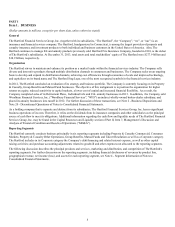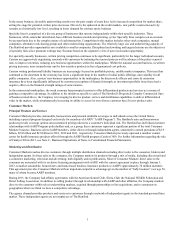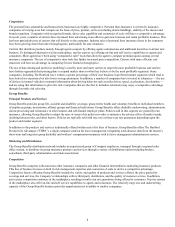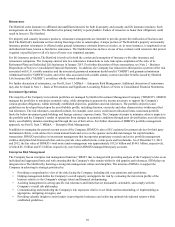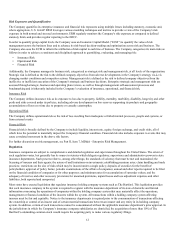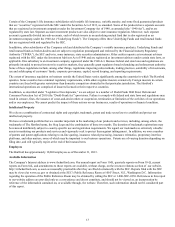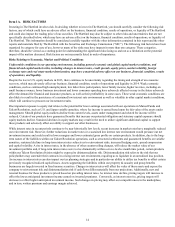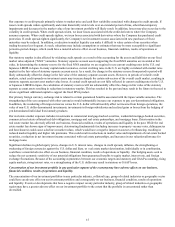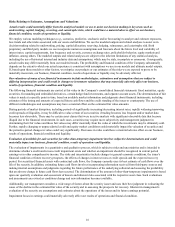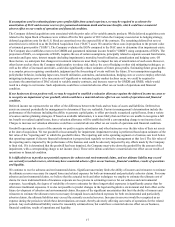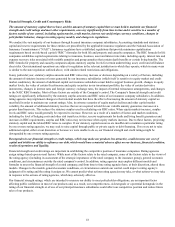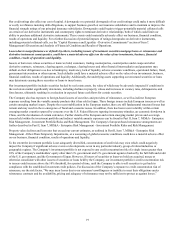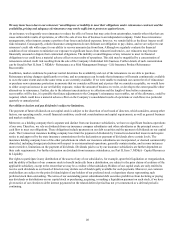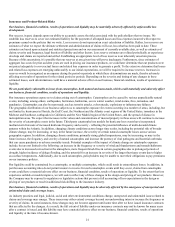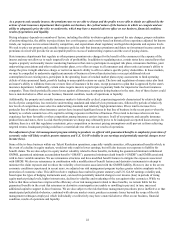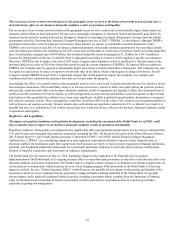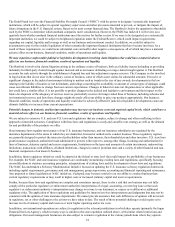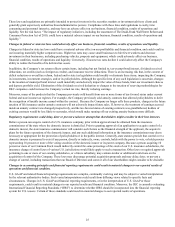The Hartford 2013 Annual Report Download - page 15
Download and view the complete annual report
Please find page 15 of the 2013 The Hartford annual report below. You can navigate through the pages in the report by either clicking on the pages listed below, or by using the keyword search tool below to find specific information within the annual report.15
Our exposure to credit spreads primarily relates to market price and cash flow variability associated with changes in credit spreads. If
issuer credit spreads widen significantly and retain historically wide levels over an extended period of time, other-than-temporary
impairments and decreases in the market value of our investment portfolio will likely result. In addition, losses may also occur due to the
volatility in credit spreads. When credit spreads widen, we incur losses associated with the credit derivatives where the Company
assumes exposure. When credit spreads tighten, we incur losses associated with derivatives where the Company has purchased credit
protection. If credit spreads tighten significantly, the Company's net investment income associated with new purchases of fixed
maturities may be reduced. In addition, a reduction in market liquidity can make it difficult to value certain of our securities when
trading becomes less frequent. As such, valuations may include assumptions or estimates that may be more susceptible to significant
period-to-period changes, which could have a material adverse effect on our business, financial condition, results of operations or
liquidity.
Our statutory surplus is also affected by widening credit spreads as a result of the accounting for the assets and liabilities on our fixed
market value adjusted (“MVA”) annuities. Statutory separate account assets supporting the fixed MVA annuities are recorded at fair
value. In determining the statutory reserve for the fixed MVA annuities we are required to use current crediting rates in the U.S. and
Japanese LIBOR in Japan. In many capital market scenarios, current crediting rates in the U.S. are highly correlated with market rates
implicit in the fair value of statutory separate account assets. As a result, the change in the statutory reserve from period to period will
likely substantially offset the change in the fair value of the statutory separate account assets. However, in periods of volatile credit
markets, actual credit spreads on investment assets may increase sharply for certain sub-sectors of the overall credit market, resulting in
statutory separate account asset market value losses. As actual credit spreads are not fully reflected in current crediting rates in the U.S.
or Japanese LIBOR in Japan, the calculation of statutory reserves will not substantially offset the change in fair value of the statutory
separate account assets resulting in reductions in statutory surplus. This has resulted in the past and may result in the future in the need to
devote significant additional capital to support the fixed MVA product.
Our primary foreign currency exchange risk is related to certain guaranteed benefits associated with the Japan variable annuities. The
strengthening of the yen compared with other currencies would substantially increase our exposure to pay yen-denominated obligations.
In addition, the weakening of foreign currencies versus the U.S. dollar will unfavorably affect net income from foreign operations, the
value of non-U.S. dollar denominated investments, investments in foreign subsidiaries and realized gains or losses from the hedging of
yen denominated individual fixed annuity products.
Our real estate market exposure includes investments in commercial mortgage-backed securities, residential mortgage-backed securities,
commercial real estate collateralized debt obligations, mortgage and real estate partnerships, and mortgage loans. Deterioration in the
real estate market has adversely affected our business, financial condition, results of operations and liquidity in the past. While the real
estate market has shown signs of improvement, deteriorating fundamentals (including increases in property vacancy rates, delinquencies
and foreclosures) could cause a decline in market values, which would have a negative impact on sources of refinancing, resulting in
reduced market liquidity and higher risk premiums. This could result in reductions in market value and impairments of real estate backed
securities, a reduction in net investment income associated with real estate partnerships, and increases in our valuation allowance for
mortgage loans.
Significant declines in global equity prices, changes in U.S. interest rates, changes in credit spreads, inflation, the strengthening or
weakening of foreign currencies against the U.S. dollar and Euro, or real estate market deterioration, individually or in combination,
could have a material adverse effect on our business, financial condition, results of operations or liquidity. Our hedging assets seek to
reduce the net economic sensitivity of our potential obligations from guaranteed benefits to equity market, interest rate, and foreign
exchange fluctuations. Because of the accounting asymmetries between our economic targets and statutory and GAAP accounting, rising
equity markets, rising interest rates, or a strengthening of the U.S. dollar may result in statutory or GAAP losses.
Concentration of our investment portfolio in any particular segment of the economy may have adverse effects on our business,
financial condition, results of operations and liquidity.
The concentration of our investment portfolios in any particular industry, collateral type, group of related industries or geographic sector
could have an adverse effect on our investment portfolios and consequently on our business, financial condition, results of operations
and liquidity. Events or developments that have a negative impact on any particular industry, group of related industries or geographic
region may have a greater adverse effect on our investment portfolio to the extent that the portfolio is concentrated rather than
diversified.


